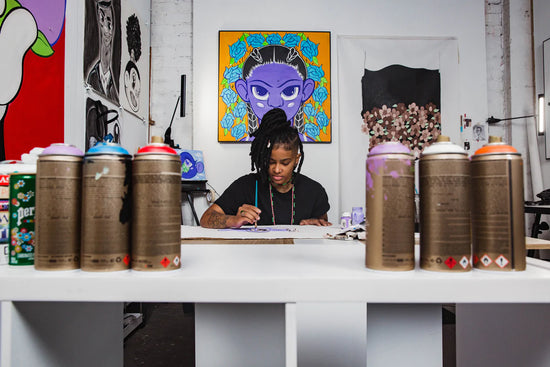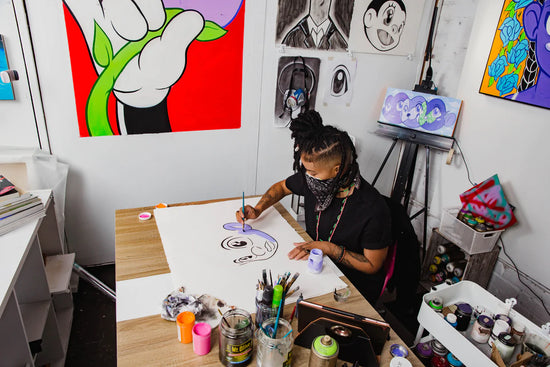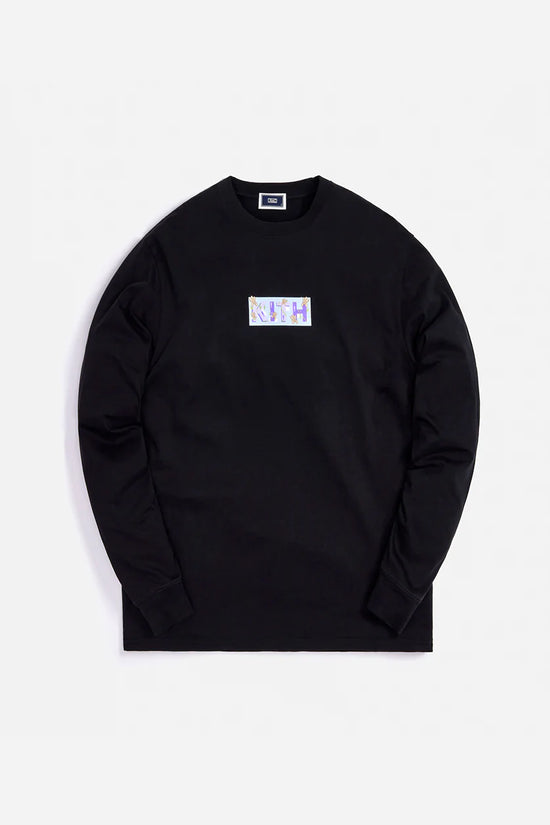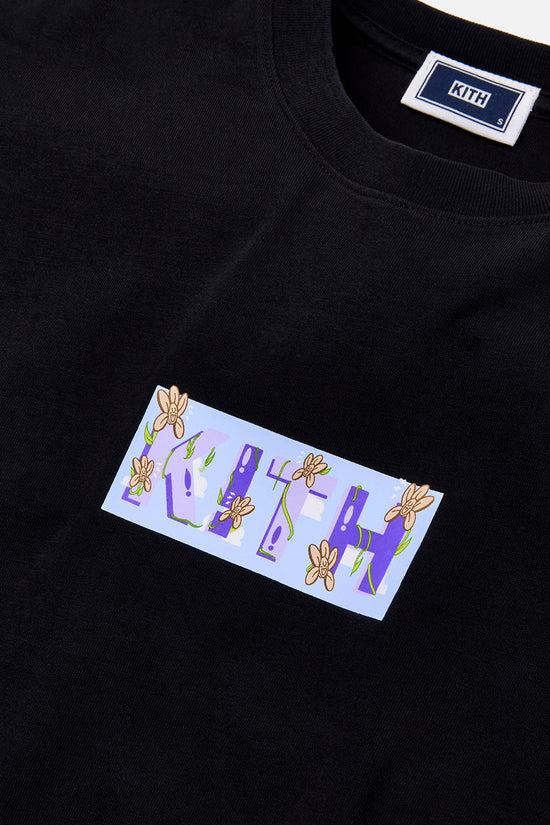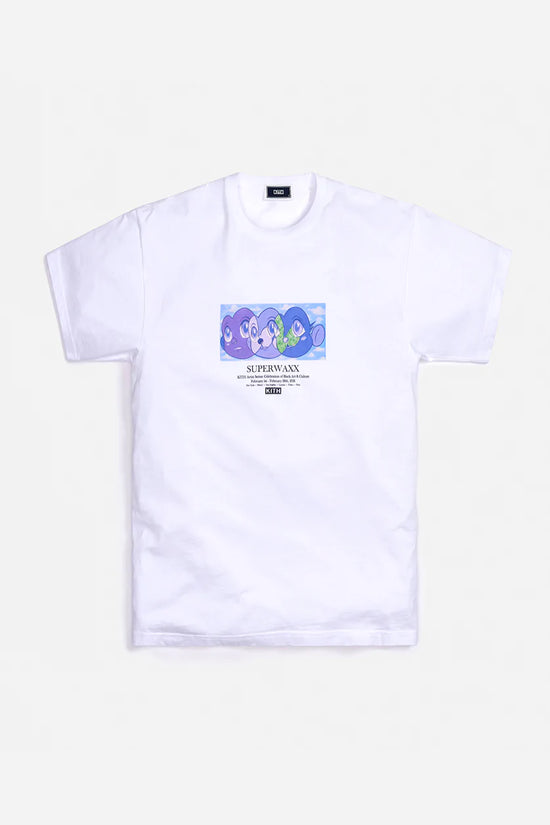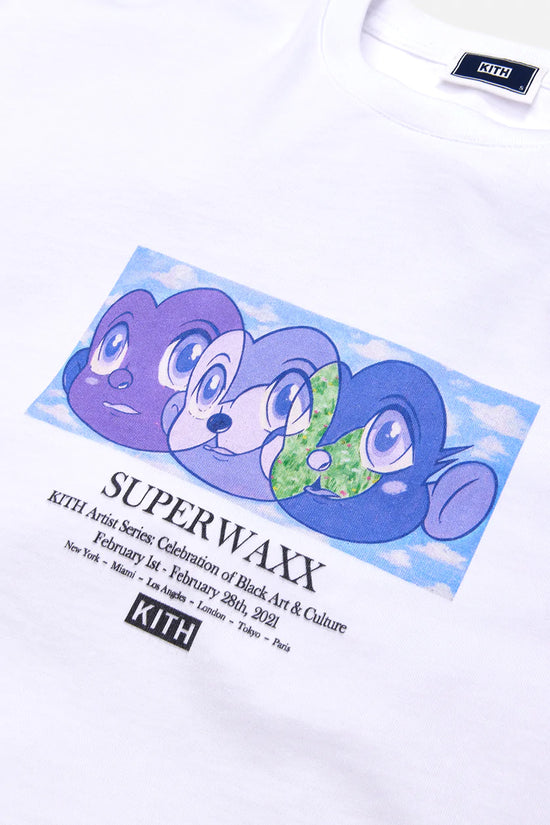To celebrate Black History Month, we have worked with three Black artists to create a capsule that will release on February 8. Each artist has reimagined our classic logo in their signature style
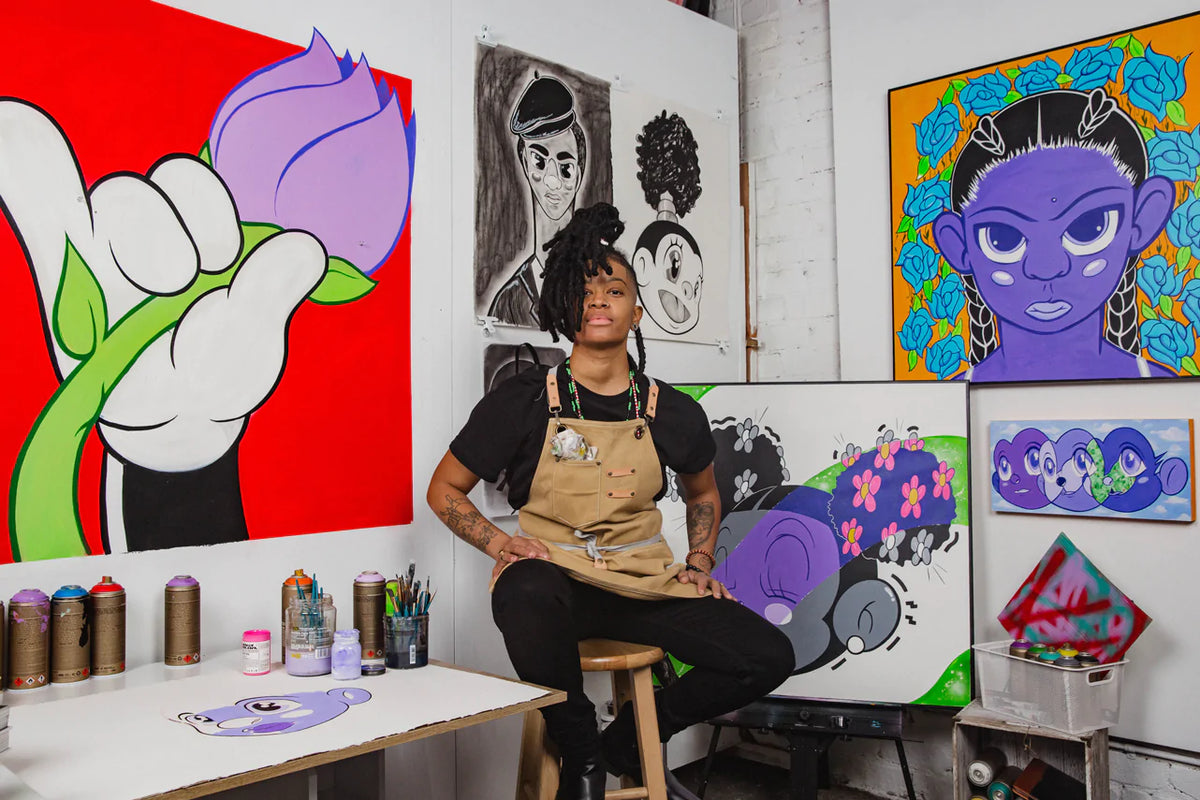
The first artist is Los Angeles-based SUPERWAXX, whose work combines a pop art sensibility with the aesthetic and influence of animated film and television, comic books, and street art. Cultivating her passion for art at an early age, she studied her favorite Saturday morning cartoons, alongside comics and graffiti magazines, anime films, and pop culture icons. Using fine line painting techniques and imaginative character designs, SUPERWAXX is best known for her signature eye-catching expressive style.
She has exhibited internationally, with shows in Boston, New York, Miami, Cuba, Los Angeles, Tokyo, and Washington, DC. Recent collaborations include a cross-city installation of the ! AM SUPER campaign with the Hirshhorn Museum and Sculpture Garden in DC, and executing a large work for the United States of Women Summit in LA.
Greg Betty, Kith's Senior Graphic Designer who worked with the artists to create the apparel capsule, sat down with SUPERWAXX to have a conversation about influence, her process, the importance of identity in the Black community, and more.
Photography by Tayo Kuku
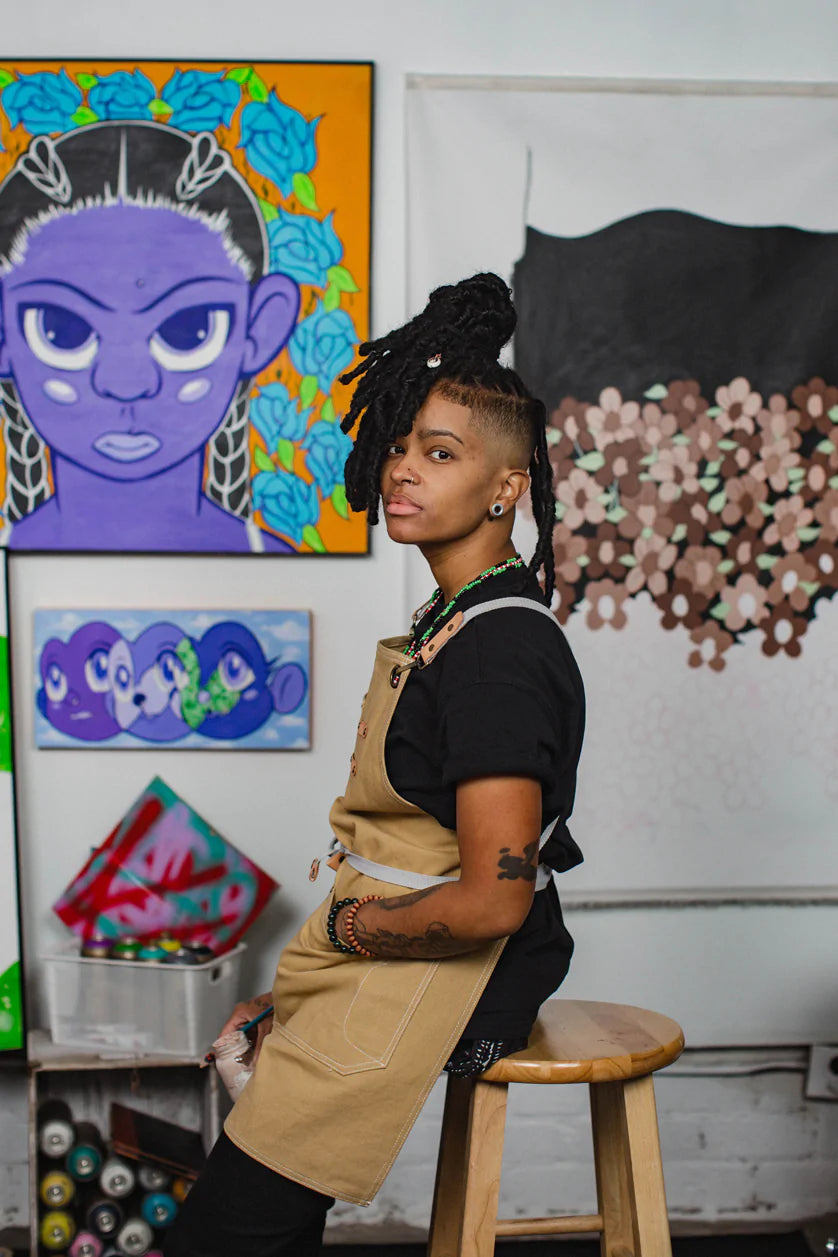
GB: We are finally meeting for the first time, even though we have been working together digitally for awhile now. It's a pleasure to do this interview with you. Before we get into your work, can you tell us how you came up with the name SUPERWAXX? I feel like it fits you perfectly.
SW: The name SUPERWAXX actually came from my tagger name. I used to get up in my hometown in Richmond, Virginia and I started out as just WAXX. I would just get around the north side of the city, just throwing up tags. I was still working on my burner piece at the time.
GB: What were you tagging?
SW: Walls. I was using the fat sharpies, tagging up postal boxes and signs. Just the regular, graffiti writers just tagging whatever.
GB: You would’ve loved New York…
SW: Oh yeah, every time I visited New York, I loved it. Just seeing all the artwork, it's like having an art gallery in the street. But yeah, the tag was WAXX and then I moved to Washington DC, where I got involved with a team there. After that I began showing my work in galleries, so I transitioned from the street to the gallery space and when that happened, I saw it as an evolution as an artist. Kind of like when you think about Dragon Ball Z, you go Super Saiyan and that's how I saw my evolution as an artist. That's how SUPERWAXX came together.
GB: When I think about Richmond, immediately I think about The Clipse and N.E.R.D. and that whole Star Trek movement, which is like a black reinterpretation of Sci-Fi. That movement helped redefine what was actually cool in pop culture. Can you tell us a little bit about what it was like growing up in Richmond?
SW: There have been some greats out of VA. Like you said, you have The Clipse, The Neptunes, Pharrell, and we can't forget about Timbaland, Missy Elliot, you know the list goes on. When it comes to growing up in the South, I think it's great because for me one of my fondest memories is spending a lot of time in nature, which I think certainly helped me creatively as a kid. I was just going into the woods and letting my imagination run wild with my friends. As an adult now, Richmond has a whole different vibe to me. The art community is growing tremendously. You have colleges like VCU whose art community is growing, you have incredible murals in the city wherever you go, and you have galleries in Northern Virginia like Art Whino which one of my homies from DC who was the head of the Richmond Mural Project helped to open, so there’s a lot of art and vibrancy there. Me being Black, the history of Richmond is crazy, like the slave trade and everything that happened there, So now going back home is about exploring that history and understanding that.
GB: Getting into your work a bit, your work has been shown all over the world and reached so many different people, cultures and backgrounds, which is like every artist's dream. Going from group shows to solo shows, to partnerships with fashion brands and everything in between, there's no stopping you. You're really living up to this super name that you gave yourself. Can you tell us a little bit about those experiences and what those moments mean to you?
SW: It’s been a great trip and journey thus far. I've grown tremendously, not just as an artist but as a person through these experiences and the people I meet and who connect to my work. I really want to be able to give people a sense of a connection and so working with all of these incredible brands like Kith is really humbling because Kith is just dope on so many levels. It's fantastic because it helps me grow and allows me to continue to expand my mind, my vision and ways to connect with a bunch of people all around the world in different cultures, backgrounds, communities so overall it's been a great experience.
GB: What do you think is the most impactful project you have worked on?
SW: I've done a lot of really fun and interesting things with my work, and I have collaborated with a lot of people who also do some really impactful things. I don't know if I can pinpoint one particular project but what I can say is one of the most memorable moments for me was around 2015. I was showing an artwork that was inspired by the 2011 Japanese Earthquake and kind of the experience that Japanese people may have had with that, and historically they’ve overcome a lot. So I created this artwork that had Astro Boy in it, and there was a Japanese gentleman and we began talking about the piece. He was asking me what it signified and became really emotional about it and said something like, “I don’t think you understand how much this piece means, especially for someone of Japanese heritage and who had family members impacted by the earthquake.” He went on to buy the piece because he felt really drawn to it, and that was a moment that really stood out to me. I want to carry that with all of my projects. Any time I’m doing a collaboration I revisit that moment.
GB: Your work is deeply rooted and inspired by pop culture icons, anime, computer games, comics and graffiti. Like Warhol, KAWS, and Murakami, who you’ve said is one of your inspirations. I feel like you've been taking in a little bit of everything from culture and reimagining it in your own expressive and unique style. I vividly remember Saturday morning cartoons on WB 11 and playing Megaman and Pokemon underneath my covers at night so my mom didn’t know. And how mad I would be if I missed an episode of Dragon Ball Z on Toonami and I’d have to wait a whole year to see that episode. I feel like when I look at your work, all those feelings of childhood nostalgia come back to me. When did you come up with this signature style of just reimagining pop culture through your own lens?
SW: It's interesting that you even bring up your childhood experiences like watching Saturday morning cartoons and playing video games. Honestly, the way I learned to create and draw was actually through recreating the cartoons that I watched and comic book characters that were in the comic books that I purchased. So it really started at an early age and it just carried on throughout my adulthood as a creative. I started to get into graffiti because of my brother Anthony. He was a graffiti writer and when I was a little girl, I would lay beside him and try to copy and mimic his black book sketches. He hated it as an older brother, but I credit a lot of my creativity to him. Then I got introduced to artists like Murakami, who I think really broke the gate open for the Fine Art World to really recognize that anime aesthetic as fine art. That recognition really helped me think in a broader sense of how I create my work and being influenced by cartoons, comics, video games and skateboarding culture.
GB: They are all from the same world at the end of the day. They all come from the same type of person, that outsider individual.
SW: Totally. Then as I got more into Murakami, it opened me up to a whole world of so many other prolific artists. Whether it be Black artists like Charles White, Elizabeth Caplet, or Jacob Lawrence.
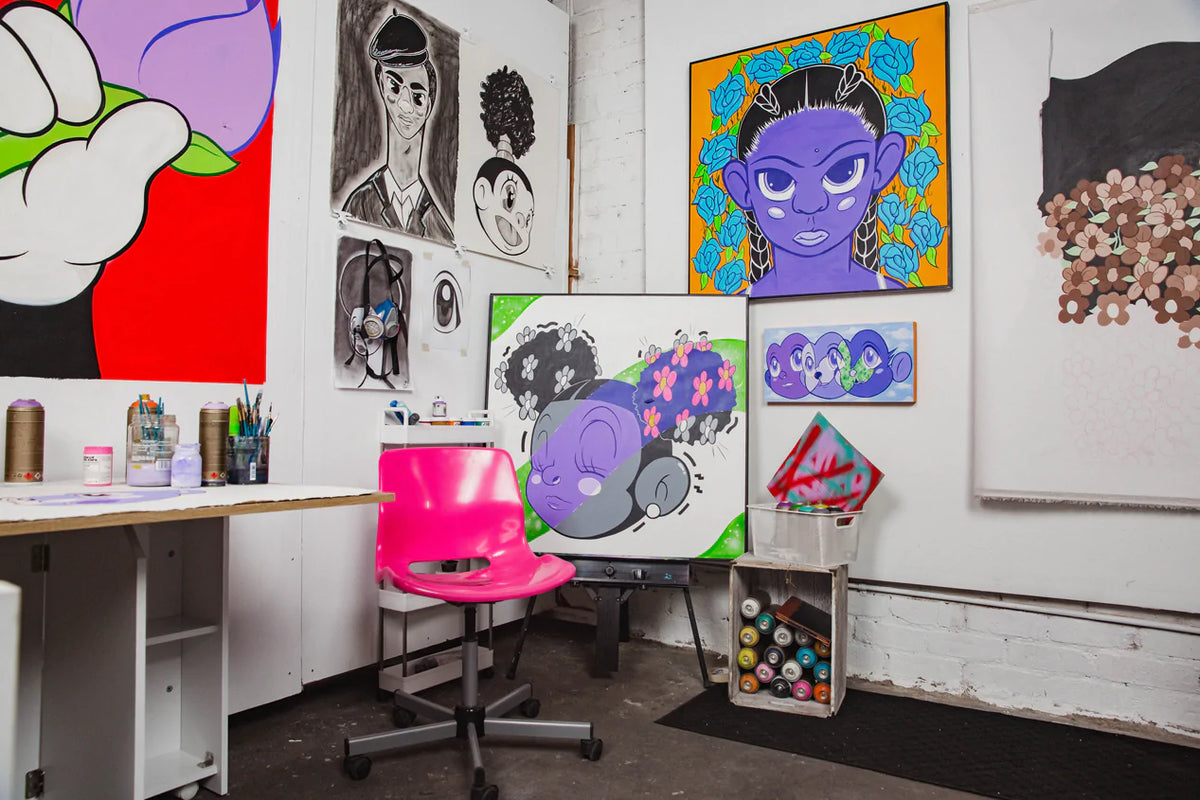
SW: I began to learn more about those artists and their styles. Emory Douglas, who created the imagery for the Black Panther. That set of work helps and inspires me as well. It's just a mesh of all these different styles that really helped me in terms of finding my voice as an artist.
GB: Just like you're inspired by all these different forms of art, when I look at your art, I also see that you’re heavily influenced by global issues. Whether they're social, religious, political, or economical. What type of issues are you really trying to address in your work?
SW: I don't know if there's a particular issue specifically. It's just whatever speaks to me, whatever really touches me in a way. I want to amplify the voices of these people who may be suffering due to whatever social, environmental or political issues may be impacting them. So I feel like I'm just an extension of their voice, you know through an artist’s perspective. I participated in this exhibit called We Rise which happened here in Los Angeles where they did a group exhibition with all these incredible artists creating work around mental health. I created a piece about African American children and how they are impacted by suicide and their increasing suicide rate. So I created the Dragonfly Girl to speak to that, as I wanted my work to inspire hope. So it really depends on what speaks to me and what I feel calls to me to create the work. Although I am Black and I am queer and I am a woman, I don't specifically make work just in regards to that. It's really about the human experience for me in terms of what calling or topic is attached to my work.
GB: I wanted to get a bit deeper and talk about identity. In hip hop, we have a number of artists such as Pharrell, MF Doom, Wu-Tang and Lupe Fiasco who were heavily influenced by seemingly taboo things in Black culture like comics, anime and cartoons. Growing up it was almost like black people shouldn’t watch anime, and if you did you were looked at differently in your own community. But these artists have redefined what it means to be Black and creative and have ultimately created a subculture within our culture. For me, being Black and being influenced by all these things helped me maneuver and see the world differently. Whereas the other artists we worked with on this project put an immense focus on the Black experience in their work, I feel like you’ve taken an overall humanitarian approach. I watched an interview you gave in 2016 where you stated that because you didn't have a close relationship with your biological mother, you felt like there was a void that you used art as a means to fill, while simultaneously spreading love. I feel like that's why your work isn't solely focused on Black-related issues because you're thinking about women's rights, civil rights, climate issues, gender inclusion, equality and education like a true superhero. Are you trying to change the narrative or the landscape of what it means to be a Black artist for future generations?
SW: I don't know if I'm necessarily trying to change it so much as I want to be a reminder that we can do more than just speak to our own experiences. To me personally, just because I am Black does not mean that my work has to focus on black-ness. Just like you said, when I was growing up it wasn't cool to be into anime and skateboarding. They would try to roast me in the hallways for bringing a board. I remember one time a classmate tried to roast me for being into skateboarding and being a chick, calling me Tony Hawk. They thought that was funny and a diss but to me I was like I’ll take it, that’s cool. I'm glad people like Lupe Fiasco helped to break down those barriers just through hip-hop or even Pharrell, because that was the point when it shifted. I think specifically within the past four years we definitely seen this shift in regards to what it means to be Black. You can listen to rock music, I was just listening to the Foo Fighters a minute ago, just living my life getting ready for this interview. I think we're broadening our understanding that we are not solely defined by the color of our skin as artists and that we can create all different types of work and be inspired by all different sorts of things and that's why I like creating work around the Japanese experience. I'm not Japanese at all but I respect them and I see that they have been resilient in overcoming atrocities and things that they have gone through and have come out of that like a phoenix with all this incredible art and technology. The fashion game in Japan, I know you said you went there.
GB: Listen, I’m telling you I really almost stayed. Tokyo is a whole other place, man. I changed my whole closet out after I came back. I had to pay extra for my suitcase, it was that crazy.
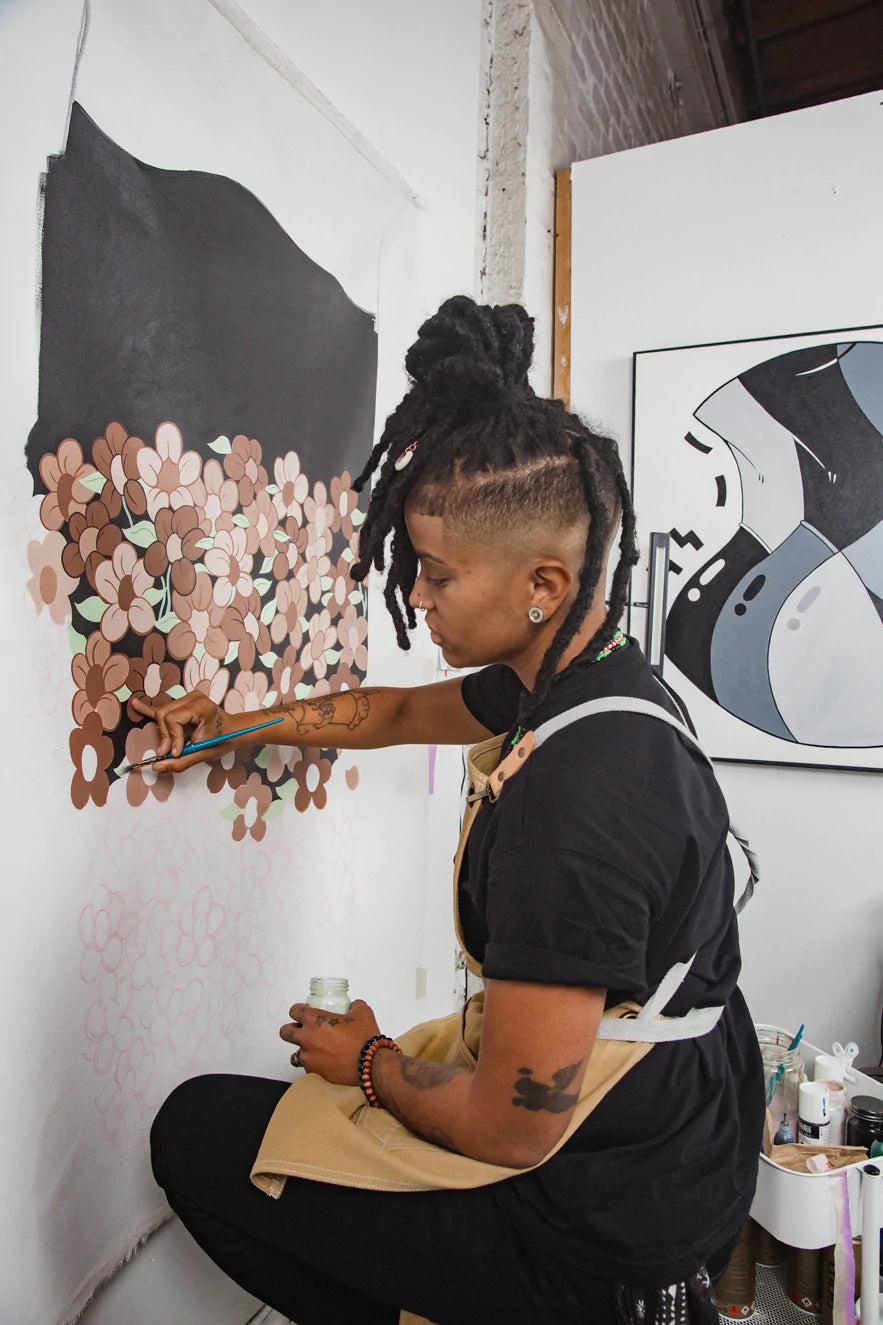
GB: I want to talk to you about the importance of family, especially the Black-American household. What does family mean to you?
SM: Family is my foundation. It's what I know and I also challenge myself to break generational cycles in which I see how my parents were raised, how they decided to raise me, and in my everyday actions. It's nurturement and continues to feed the fire I have inside. I think a lot of people get out in the world with their careers and forget where they come from. I think it is so important because I wouldn't be who I am today without my father and my grandma who raised my father to be the man that he needed to be. My grandmother stepping up and being an incredible woman led my dad to teach me a lot of things. He was very militant then but now I understand him and I give thanks. I pay homage constantly to him, my grandma, and my mom. It's important to remember your roots and never forget that because so many people want to separate that identity or don’t even know where they come from, unfortunately. In different instances, we all have different family dynamics but I want to let the world know that the real McCoy family, we are solid. If you ever meet a McCoy, know that you're in good company. We humble ourselves in that and are also very prideful. We want to continue to change the narrative because McCoy is a white Irish name. I don't know what my descendants look like, all I know is who I can be today carrying that last name and my family is really proud of that.
GB: I love that and it perfectly segues into my next question. Although I'm a Black-American, my entire family migrated to America from Jamaica. My grandma is Jamaican and German, I’m the first male born here and I’m still figuring it out as I go. I'm sure there are a lot of similarities and differences between our households, such as tradition, music, food and mannerisms. Do you feel like even though our upbringings are different, our struggles are still the same?
SM: We are all a part of the diaspora at the end of the day. I think it is so important to recognize the differences and unity as being one because a lot of people have a tendency to celebrate and be prideful. There is nothing wrong with being prideful of where your people come from but we are one and we have to bring that full circle because people are going to look at us as the same folks in this country. I think our struggles are the same and also very different.
GB: How is this feeling of depicting “Black unity” shown in your work?
SM: I want to say Black unity because I also share Afro-Latino heritage and we have folks all across the range of melanin. I think it's so important to depict that through my work because that's who I am and that's where my people come from. Although I did not know my great-grandmother from Mexico, I do see images of her. I see my grandma and her siblings and my grandpa in all these images. I think it is so important to show how dynamic the range and complexity of Black folks is. We're not just one type, there is so much culture to that and we should accept that and welcome it with open arms. It is such a good feeling to walk in your full Blackness and recognize your lineage, and understand this identity is so strong across the nation.
GB: When I was putting your version of the logo together, I definitely wanted to make sure there was emphasis on the face and the texture that you use. I even filled the K I T H with your texture just to show people that this is what you do. Now that I know that it's your dad on the classic logo, it makes it even better. How does he feel knowing that he's going to be on the logo?
SM: He feels really good. Sometimes I have to be careful though because I’m not trying to blow his head up too big now. He's proud and I am so humble and happy to be able to have my family be a part of this just as much as the art is.
GB: You said you wanted to be a teacher and I think you're teaching me a lot right now just through this conversation. I want to talk about our collaborative project; we asked each artist to reinterpret the Kith classic logo in their own stylistic way. Can you explain to us who Troy Lee is and what does this person being intertwined in the Kith classic logo mean to you?
SM: Honestly, that's my dad, I painted my father as a young boy. He had this striped sweatshirt in this little Polaroid. I painted it and then produced a print of it and it was so beautiful to see because the portrait had a yellow background and you see my dad's little afro and it's got the hair texture that I use and his face also resembles a sunflower. I thought it was perfect to use for Kith for the colors and his name starts with a T so he's right on the T on the classic logo.
GB: To get into our project, we asked each artist to reinterpret the Kith classic logo in their own stylistic way. Can you explain to us your thought process going into the design of animated flowers and what they mean to you?
SW: Flowers are symbolic of so many things. Just speaking to Murakami, why he chooses flowers to be his iconic thing is because they resemble so much. The style and the interpretation of the flowers that I have is that I wanted to use the colors of people’s skin versus just using pinks and purples and blues. I wanted to think of it in a way where what if we ourselves were flowers in this world. Then taking those colors which would usually be used when painting flowers and putting that into the color of the characters’ skins. That's why I paint my characters using purples, also because purple also has its own symbolism of royalty as well. So yeah, when it comes to flowers, it's really about considering or thinking specifically about us Black people in this world as flowers or in a garden.
GB: Thats beautiful. I'm looking at your work in a different light now. I loved it but now I'm deeply in love with it, just from that explanation. Let’s get into the second piece. What did that second body of work mean to you and why did you choose it?
SW: With the second artwork that's used for the garments, it really speaks to using the color purple to interpret Black skin. There is also this character that is looking for hope in the sky. Let’s talk about the last four years, just wanting to give that sense of hope and people seeing this collaboration with Kith and see that things are possible. Coming out of the problems we’ve been going through and having a global brand like Kith reaching out to Black artists, even the other artists featured in this project who are tremendously talented and really dope, I just wanted to give that sense of hope in design. That was really the intention behind that piece, specifically.
GB: Thank you for the shout out but it's all credit to you and your work. You're showing the next generation that it's possible to be yourself and that people are watching, no matter what you do. The one thing I’ve taken into consideration throughout my career is that the higher I go, the more I have to give back. You also have that responsibility as an artist, and it’s something we have to be conscious of no matter what.
SW: Outside of being an artist, I'm also an arts educator and I work with preteens and teenagers by teaching them art and also leading the Black student union at the school that I teach at. So, I get a really close look at what the next generation is feeling and what their thoughts are, especially during this time. So yeah like you said, I think it is our responsibility as creatives and as artists to consider who's coming behind us and what we represent to them. I told one student that I was doing this collaboration with Kith because he wants to work in fashion and he just lit up. I told him, “Let's get on a call and talk about it,” just so I can tell him what the experience was like so that I could help and assist him along his way. It definitely is about giving back and I think it's great what Kith is doing as a company and really just all the projects you guys are rolling out. I just saw that Kith Community thing being announced today. It's just about giving back and that's what’s most rewarding.
GB: At the end of the day, it's about learning. We all have to teach each other to be better people and hold everybody accountable and let us learn and grow together.
SW: But we need to look within ourselves and be accountable, like “who am I?”, being a light as much as possible in the world.
GB: You really are a superhero. Before we hop off, I have one last question. What can the world expect next from SUPERWAXX?
SW: I really just want to continue using my talents, my gifts, my abilities and my ideas to give back. That's what it really is about for the future. I don't really focus so much on the end goal or the destination so much as the journey. So much for me has manifested on this path in ways that I never would have imagined it. But then to really see it is just incredible and I look forward to connecting with more people. Hopefully in the future I’m doing more things with Kith and connecting with others who are really creative and imaginative and really want to make change in the world, regardless of whatever their creative medium is. Because for you guys, your medium is fashion, for me, it’s paint. So just blending those things together to really give back and connect with the community.
GB: Thank you WAXX. This interview was amazing.
SW: Thank you.

